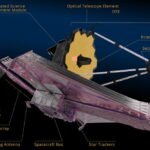
The James Webb Space Telescope, now fully deployed and in its final orbit, continues to make progress as the team readies the telescope for science operations in a few months. This week, the telescope turned on its high-gain antenna, which enables to telescope to send data to Earth and receive commands via NASA’s Deep Space Network.
The diagram below shows the major components of James Webb, now everything is deployed and the observatory is in its final configuration. The antenna is on the underside of the telescope here, coming off the spacecraft bus which is the home for essential systems like power, altitude control, and communications.
Webb’s major subsystems and components.
As with other parts of the spacecraft, the antenna was extensively tested on Earth before it was ready to be used in space. The antenna was released in December last year, just one day after the launch of the spacecraft, as part of the gimbaled antenna assembly. According to NASA, the antenna will be under a lot of use as it will need to send at least 28.6GB of science data from Webb to Earth twice per day. The data will be sent through space and picked up by NASA’s Deep Space Network, which has three locations around the globe so that there is always at least one location that can maintain contact with Webb as the Earth spins.
In order to make the sending of data efficient, Webb will send data over a part of the electromagnetic spectrum called the Ka radio band. “The team also turned on the High-Gain Antenna, enabling downlink to Earth through the Deep Space Network using the Ka radio band,” NASA wrote this week. “The Ka-band provides a much higher data rate than the S-band that Webb has been using for communications up until now. The Ka-band and the High-Gain Antenna will eventually allow the observatory to send all of the science images and data down to the ground for astronomers around the world to analyze and make discoveries.”
NASA has also shared that Webb’s first target will be the star HD 84406. This is a very bright star — in fact, it will be too bright for Webb to study once the telescope is focused — but that makes it ideal for collecting engineering data during the process of aligning Webb’s mirrors.
Research Snipers is currently covering all technology news including Google, Apple, Android, Xiaomi, Huawei, Samsung News, and More. Research Snipers has decade of experience in breaking technology news, covering latest trends in tech news, and recent developments.